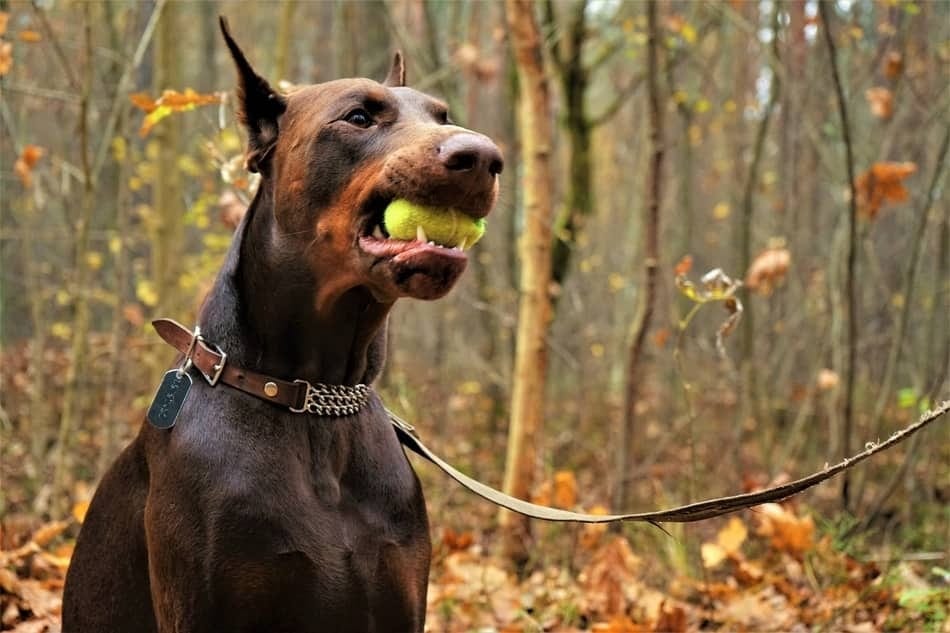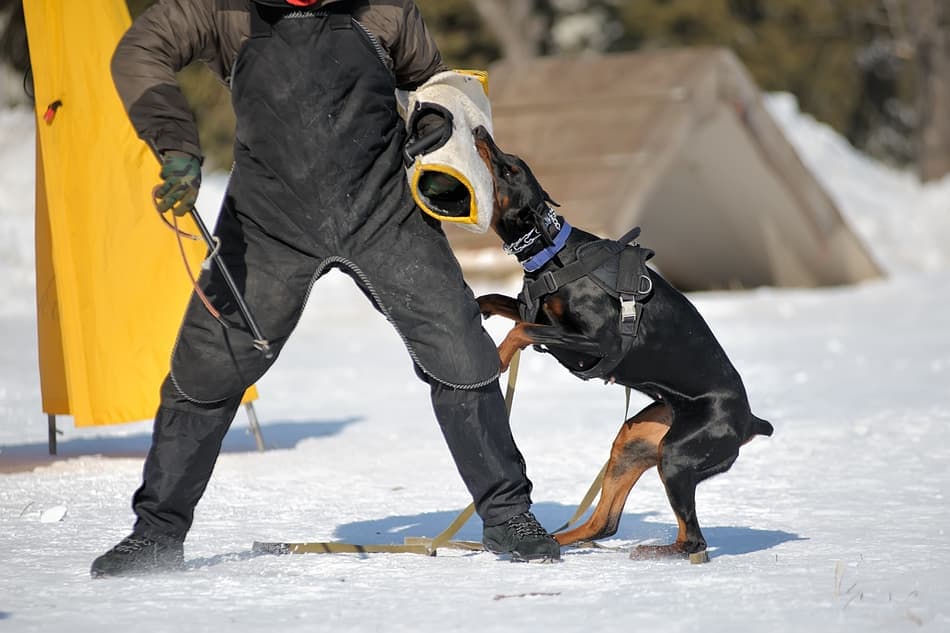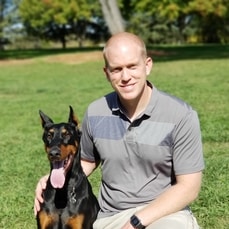
I always knew that Dobermans were strong, powerful dogs but when I first got interested in getting one, I often found myself wondering how strong their bite actually was and how it compared to other dog breeds. I did countless hours of research on this, and the answer was rather surprising.
What is the bite force of a Doberman Pinscher? Although it is a common myth that a Doberman has a bite force of 600 PSI, this claim is largely unsubstantiated. It is generally accepted that the bite force of a Doberman Pinscher is 305 PSI. However, there are many factors other than the breed that can affect the strength of a dog’s bite.
There is actually a lot that goes into the force of a dog’s bite. Factors such as health, size of their body, size and shape of their skull, and physical conditioning can make a big difference. That’s why you will often see conflicting reports from various sources on the force of a Doberman’s bite. One source even claims a 600 PSI bite force. But is this really possible?
Calculating the True Doberman Bite Force
Bite pressure is generally measured in PSI or “Pounds per Square Inch.” This refers to how many pounds of pressure are applied per square inch. So if the force is 150 PSI, that’s the same pressure as a 150-pound person standing on just one square inch of your hand. Painful right?
When researching the force of a Doberman’s bite, I discovered that the most commonly measured bite force numbers are: 245 PSI, 300 PSI, 305 PSI, and 600 PSI. In fact, the rating of 305 PSI has been reported multiple times by many different reputable outlets.
When looking at these numbers it is clear that the 600 PSI rating seems far off from all other ratings that exist online. But why? Many claim this is a rumored number that has never been substantiated and true to those claims, I was not able to find any first-hand accounts of a Doberman actually being measured as producing that amount of force.
In fact, many good arguments exist as to why this number is merely a myth and should not be considered accurate. They include:
- It’s far above and beyond the pressures that any other domestic dog can produce, and similar to the power a lion can produce in their jaws.
- The Doberman’s snout is long and thin, which is traditionally a hindrance when it comes to applying bite force.
- The small head of a Doberman is also a disadvantage when it comes to applying force in the jaw area.
- Other dogs (such as the Rottweiler with 328 PSI of biting force) have much shorter noses and bigger heads, which are typical characteristics of an animal with a strong bite and these dogs cannot come anywhere near the 600 PSI number. This was confirmed in a 2005 National Geographic Study conducted by Dr. I. Lehr Brisbin at the University of Georgia.
- Due to the lack of supporting evidence, it’s logical to conclude that the 600 PSI rating of the Doberman’s bite should be disregarded as likely just a myth. So if that’s the case, what’s the true number? The answer is most often reported as 305 PSI. This number has been reported by reputable multiple outlets and is logical considering the physical traits of the Doberman. That’s why I consider this to be the most accurate number.
Although a dog’s breed does play a significant roll in determining how strong of a bite the dog is capable of, there are many other factors that can play an equally large role.
DID YOU KNOW?
There are two variants of the Doberman, the European and the American. Evidence suggests that the European may have the stronger bite. To learn the differences between these two, see my article American vs. European Doberman: A Side-by-Side Comparison.
Other Factors that Determine a Dog’s Bite Strength:
- Age and health of the dog.
- The individual strength of a specific dog. An active dog who gets frequent exercise will typically have a stronger bite than one that doesn’t. See my article about how to build muscle in a Doberman for more on building strength and stamina.
- The grip they have on the object they’re biting. A deeper grip usually produces more force.
- The thickness of the object they are biting. A thicker object that spreads the jaw open further is harder to apply force to.
- The dog’s willingness to apply maximum effort into a specific bite.
Since there are many variables affecting how strong a dog’s bite is, any numbers representing the force of a Doberman’s bite (or any dog’s bite) should really only be considered an approximation.
Even though rumors of a 600 PSI (pounds per square inch) bite force in Doberman’s may not be entirely accurate, they are still incredibly impressive and strong dogs. In fact, their scissor-like jaw action, which can inflict multiple bites in very rapid succession, makes their bite one of the most dangerous in the world.
The bite force of 305 PSI is also significant enough to put the Doberman Pinscher in the top 5 dog breeds with the strongest bite force. There are even reports of a Doberman breaking a grown man’s forearm with a single bite.
Video: The Insane Bite Force of the Doberman Pinscher
The Doberman’s “Scissor Bite”
There are various types of bites that dogs have which generally refer to the way in which the jaw closes. In the case of the Doberman, the jaw closes in such a manner where the teeth slide into place very close to other teeth in the jaw. This makes for a fairly effective slicing action when biting.
Also, the Doberman is much more likely to strike by releasing and re-biting its target in very rapid succession. These multiple quick bites can cause a lot of damage in a short time. This is commonly referred to as a “scissor bite.”
How the Doberman’s Bite Compares to Other Dogs Breeds
The Doberman’s bite is one of the strongest in the K9 world. Here is a list of other popular dog breeds along with their measured bite force so you can get a better idea of how the Doberman stacks up.
- Malinois: 195 PSI
- American Pitbull Terrier: 235 PSI
- German Shepherd: 238 PSI
- Doberman Pinscher: 305 PSI
- Rottweiler: 328 PSI
- Wolf Dog: 406 PSI
- Mastiff: 552 PSI
- Kangal: 743 PSI
Considering this is a list of the absolute most powerful biters in the dog world, the Doberman comes it at an impressive position. The Kangal is the world’s more powerful domestic dog when it comes to their bite, coming in at an astounding 743 PSI of bite force.
How the Doberman’s Bite Compares to Other Animals
While the Doberman’s bite is one of the strongest bites in the dog world, there are plenty of stronger bites out in nature. See the list below to get an idea of how it compares.
- Domestic Cat: 13 PSI
- Human: 150 PSI
- Average Domestic Dog: 269 PSI
- Doberman Pinscher: 305 PSI
- Lion: 600 PSI
- Hyena: 1100 PSI
- Bull Shark: 1350 PSI
- Polar Bear: 1200 PSI
- Crocodile: 3700 PSI
Dobermans still have much stronger bites than a human bite and even many other domestic dogs, but there are still much stronger biters in the animal the world. The crocodile comes it at first place with a jaw-dropping 3700 pounds of pressure per square inch.

Dobermans Pinschers as Guard Dogs
The Doberman Pinscher was originally created by Karl Friedrich Louis Dobermann in the 1800s. Mr. Dobermann was a tax collector in Germany who set out to create the perfect guard dog through selective breeding to keep him safe while he went out in town collecting taxes. He eventually did create the perfect guard dog, the “Doberman Pinscher.”
Not only do they make great guard dogs, but they were actually bred for that purpose from the beginning. They physically ideal for the job (strong, fast, and large-bodied) and they are mentally ideal for the job as well.
Doberman Pinschers are known for being one of the most intelligent dogs in the world. They are also extremely loyal and have a natural protective instinct. Due to their protective instincts, they will often sleep in-between their owners and the door to the room their owner is sleeping in. You’ll almost never find a Doberman sleeping with their back to a door. Many Doberman owners also report issues with excessive barking in their Dobermans. These are just a few examples of the many ways a Doberman Pinscher instinctually (with no training whatsoever) will display their aptitude for guard dog duty.
For these reasons, they have traditionally been used as police and military dogs for many years with great success. In recent years, however, some police departments have transitioned away from the Doberman due to the fact that they don’t do well in cold weather and the public perception of the breed as a “vicious breed.”
Related Questions
Do Dobermans Have “Lock Jaw”? No. In fact, no known dog breed has been discovered to have a mechanism or enzyme which causes them to “lock” their jaws. This myth has most often been assigned to the American Pitbull Terrier. Dobermans have a scissor-like jaw action and can deliver multiple bites in rapid succession.
How Dangerous are Dobermans? While in the past Dobermans were bred to promote aggressive personality traits, thanks to selective breeding most modern Doberman’s are gentle dogs that make excellent family dogs. They are one of the world’s most intelligent, loyal, and physically strong breeds.


